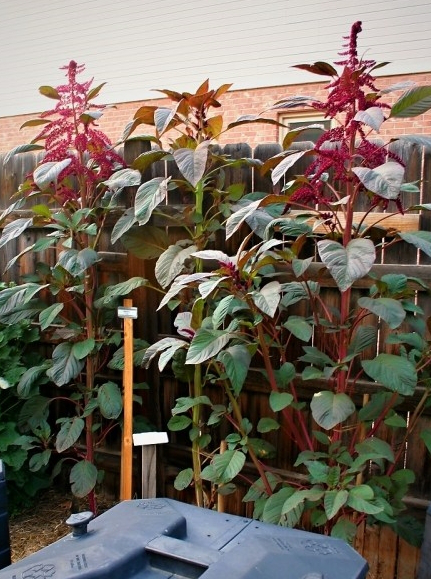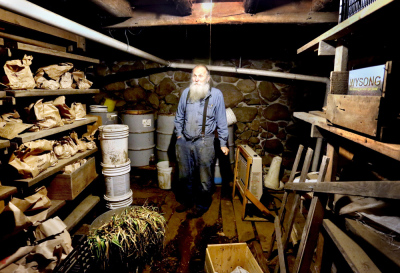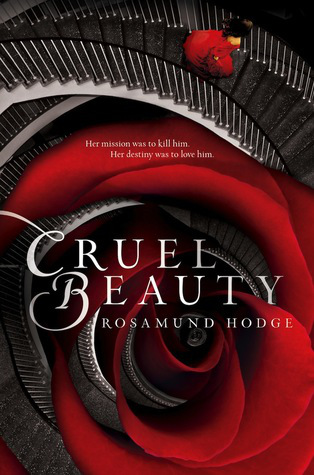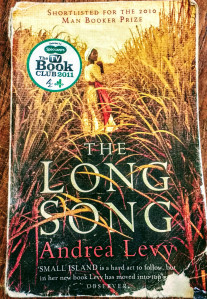
Opopeo Amaranth on July 7, well over six feet tall. Of the various locations we tried, this one proved to be the best: in full sun on the south side of a six-foot fence.
The botanical name of this impressive plant is Amaranthus cruentus ‘Opopeo’.
According to Richard Bernard writing in “The Whole Seed Catalog“, amaranth seems to have developed in the Andes, Central Asia, and Mexico in ancient times. The Aztecs cultivated quantities of the grain, especially in the “floating gardens” of their capital city Tenochtitlan.”
The good people at “Ancient Grains” tell us that:
Amaranth has quite a dramatic history. It was cultivated by the mighty Aztecs about 6,000-8,000 years ago. Amaranth was not just a food staple for the Aztecs. It played a big part in their worship. They built statues of their deity using amaranth grain and honey. These statues were worshipped, broken, and distributed for eating. This practice is the primary reason amaranth did not survive as a staple. When the Spanish arrived with Cortez, as part of their efforts to force Christianity on the pagan natives, they outlawed the grain. Amaranth fields were burned and cultivators were punished. Lucky for us, they were unable to completely destroy the grain. In a few remote areas, small amounts of amaranth survived. For awhile it was primarily used to make a traditional sweet called alegria.
The city of Opopeo is directly west of Mexico City. Presumably, this is where this variety of amaranth originated.
We purchased our seeds from Will Bonsall of Scatterseed Project. Be sure to watch the 4 minute video that appears on the main page of the Scatterseed Project site.

Will Bonsall in his root cellar at his farm in Industry, Maine, in 2013. Photo by Tim Greenway
Click HERE for amaranth growing notes by Heirloom Organics
Both the seeds and young leaves are edible and exceptionally nutritious. Amaranth leaves can be substituted in any recipe for spinach. Young leaves are tasty and are beautiful in salads.
Nota Bene: If you intend to grow amaranth mainly for its leaves, cut off the main stalk when the plant has grown to about 3-4 feet tall. In response, the plant will produce a significant number of side shoots, providing many, many more leaves. It will be a fuller, though shorter, plant. We discovered this when a fierce and devastating windstorm broke off our plants at about 3-4 feet, precisely at the height we had last staked them. We thought they were beyond hope, that it was all over, but in a very short while they were beautiful plants again, though not slim, tall, and stately as they were in the photo above.
Nutrition (Wikipedia)
One cup (245 g) of cooked amaranth grain (from about 65 g raw) provides 251 calories and is an excellent source (20% or more of the Daily Value, DV) of protein, dietary fiber, and some dietary minerals. Amaranth is particularly rich in manganese (105% DV), magnesium (40% DV), iron (29% DV), and selenium (20% DV).
Cooked amaranth leaves are an excellent source of vitamin A, vitamin C, calcium, manganese, and folate.
Amaranth does not contain gluten, so it may be a healthy and less expensive alternative to ingredients traditionally used in gluten-free products. It has high biological value and its benefits are not limited to people with gluten-related disorders, but are applicable to the general population. Quantity and quality of proteins of amaranth are superior to those of wheat. It also contains higher concentrations of folic acid than wheat . . . and its fiber and minerals contents are higher than those of other cereals.
HISTORY & FOLKLORE
Amaranth comes from the Greek word meaning “unwithering,” probably because of its long-lasting flowers. According to Andrew Chevallier,* “amaranth was sacred to the goddess Artemis, worshipped at Ephesus, and was thought to have special healing powers. As a symbol of immortality, it was used to decorate tombs and images of the gods.”
AMARANTH AS AN HERB
Again, according to Andrew Chevallier, “Amaranth is an astringent herb that is used primarily to reduce blood loss and to treat diarrhea. A concoction of amaranth is taken as a remedy in cases of heavy menstrual bleeding, excessive vaginal discharge, diarrhea, and dysentery. It is also used as a gargle to soothe inflammation of the pharynx and to hasten the healing of canker sores.”
* Chevallier, Andrew, Encyclopedia of Herbal Medicine, 2016 DK – Penguin Random House, 165
Share this:

![34347898[1]](/ai/030/582/30582.jpg)


